Choosing a Gaming CPU at 1440p: Adding in Haswell
by Ian Cutress on June 4, 2013 10:00 AM ESTFor an article like this getting a range of CPUs, which includes the most common and popular, is very important. I have been at AnandTech for just over two years now, and in that time we have had Sandy Bridge, Llano, Bulldozer, Sandy Bridge-E, Ivy Bridge, Trinity and Vishera, of which I tend to get supplied the top end processors of each generation for testing (as a motherboard reviewer, it is important to make the motherboard the limiting factor). A lot of users have jumped to one of these platforms, although a large number are still on Wolfdale (Core2), Nehalem, Westmere, Phenom II (Thuban/Zosma/Deneb) or Athlon II. I have attempted to pool all my AnandTech resources, contacts, and personal resources, together to get a good spread of the current ecosystem, with more focus on the modern end of the spectrum. It is worth nothing that a multi-GPU user is more likely to have the top line Ivy Bridge, Vishera or Sandy Bridge-E CPU, as well as a top range motherboard, rather than an old Wolfdale. Nevertheless, we will see how they perform. There are a few obvious CPU omissions that I could not obtain for this first review which will hopefully be remedied over time in our next update.
The CPUs
My criteria for obtaining CPUs was to use at least one from the most recent architectures, as well as a range of cores/modules/threads/speeds. The basic list as it stands is:
AMD |
|||||||
| Name |
Platform / Architecture |
Socket |
Cores / Modules (Threads) |
Speed | Turbo | L2/L3 Cache | |
|---|---|---|---|---|---|---|---|
| A6-3650 | Llano | FM1 | 4 (4) | 2600 | N/A | 4 MB / None | |
| A8-3850 | Llano | FM1 | 4 (4) | 2900 | N/A | 4 MB / None | |
| A8-5600K | Trinity | FM2 | 2 (4) | 3600 | 3900 | 4 MB / None | |
| A10-5800K | Trinity | FM2 | 2 (4) | 3800 | 4200 | 4 MB / None | |
| Phenom II X2-555 BE | Callisto K10 | AM3 | 2 (2) | 3200 | N/A | 1 MB / 6 MB | |
| Phenom II X4-960T | Zosma K10 | AM3 | 4 (4) | 3200 | N/A | 2 MB / 6 MB | |
| Phenom II X6-1100T | Thuban K10 | AM3 | 6 (6) | 3300 | 3700 | 3 MB / 6 MB | |
| FX-8150 | Bulldozer | AM3+ | 4 (8) | 3600 | 4200 | 8 MB / 8 MB | |
| FX-8350 | Piledriver | AM3+ | 4 (8) | 4000 | 4200 | 8 MB / 8 MB | |
Intel |
|||||||
| Name | Architecture | Socket |
Cores / Modules (Threads) |
Speed | Turbo | L2/L3 Cache | |
| E6400 | Conroe | 775 | 2 (2) | 2133 | N/A | 2 MB / None | |
| E6550 | Conroe | 775 | 2 (2) | 2333 | N/A | 4 MB / None | |
| E6700 | Conroe | 775 | 2 (2) | 2667 | N/A | 4 MB / None | |
| Q9400 | Yorkfield | 775 | 4 (4) | 2667 | N/A | 6 MB / None | |
| Xeon X5690 | Westmere | 1366 | 6 (12) | 3467 | 3733 | 1.5 MB / 12 MB | |
| Celeron G465 | Sandy Bridge | 1155 | 1 (2) | 1900 | N/A | 0.25 MB / 1.5 MB | |
| Core i5-2500K | Sandy Bridge | 1155 | 4 (4) | 3300 | 3700 | 1 MB / 6 MB | |
| Core i7-2600K | Sandy Bridge | 1155 | 4 (8) | 3400 | 3800 | 1 MB / 8 MB | |
| Core i7-3930K | Sandy Bridge-E | 2011 | 6 (12) | 3200 | 3800 | 1.5 MB / 12 MB | |
| Core i7-3960X | Sandy Bridge-E | 2011 | 6 (12) | 3300 | 3900 | 1.5 MB / 15 MB | |
| Core i3-3225 | Ivy Bridge | 1155 | 2 (4) | 3300 | N/A | 0.5 MB / 3 MB | |
| Core i7-3770K | Ivy Bridge | 1155 | 4 (8) | 3500 | 3900 | 1 MB / 8 MB | |
| Core i7-4770K | Haswell | 1150 | 4 (8) | 3500 | 3900 | 1 MB / 8 MB | |
There omissions are clear to see, such as the i7-3570K, a dual core Llano/Trinity, a dual/tri module Bulldozer/Piledriver, i7-920, i7-3820, or anything Nehalem. These will hopefully be coming up in another review.
The GPUs
My first and foremost thanks go to both ASUS and ECS for supplying me with these GPUs for my test beds. They have been in and out of 60+ motherboards without any issue, and will hopefully continue. My usual scenario for updating GPUs is to flip AMD/NVIDIA every couple of generations – last time it was HD5850 to HD7970, and as such in the future we will move to a 7-series NVIDIA card or a set of Titans (which might outlive a generation or two).
The ASUS HD 7970 we use is the reference model at the 7970 launch, using GCN architecture, 2048 SPs at 925 MHz with 3 GB of 4.6 GHz GDDR5 memory. We have four cards to be used in 1x, 2x, 3x and 4x configurations where possible, also using PCIe 3.0 when enabled by default.
ECS GTX 580 (NGTX580-1536PI-F)
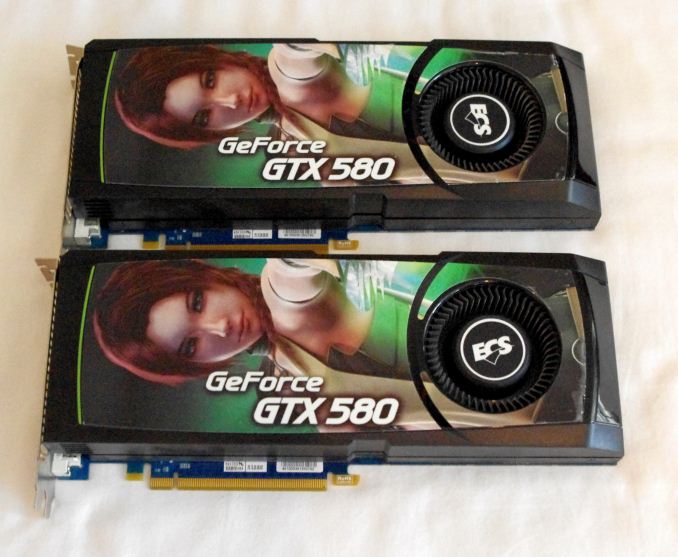
ECS is both a motherboard manufacturer and an NVIDIA card manufacturer, and while most of their VGA models are sold outside of the US, some do make it onto e-e-tailers like Newegg. This GTX 580 is also a reference model, with 512 CUDA cores at 772 MHz and 1.5 GB of 4 GHz GDDR5 memory. We have two cards to be used in 1x and 2x configurations at PCIe 2.0.
The Motherboards
The CPU is not always the main part of the picture for this sort of review – the motherboard is equally important as the motherboard dictates how the CPU and the GPU communicates with each other, and what the lane allocation will be. As mentioned on the previous page, there are 20+ PCIe configurations for Z77 alone when you consider some boards are native, some use a PLX 8747 chip, others use two PLX 8747 chips, and about half of the Z77 motherboards on the market enable four PCIe 2.0 lanes from the chipset for CrossFireX use (at high latency). We have tried to be fair and take motherboards that may have a small premium but are equipped to deal with the job. As a result, some motherboards may also use MultiCore Turbo, which as we have detailed in the past, gives the top turbo speed of the CPU regardless of the loading.
As a result of this lane allocation business, each value in our review will be attributed to both a CPU, whether it uses MCT, and a lane allocation. This would mean something such as i7-3770K+ (3 - x16/x8/x8) would represent an i7-3770K with MCT in a PCIe 3.0 tri-GPU configuration. More on this below.
For Haswell: Gigabyte Z87X-UD3H, ASUS Z87-Pro, and MSI Z87-GD65 Gaming
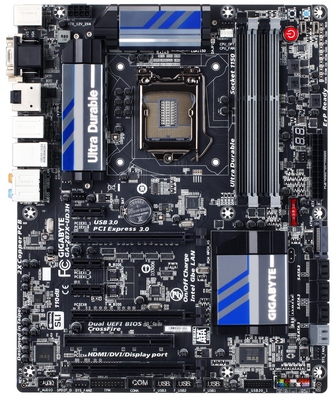
The ASUS Z87-Pro nominally offers an PCIe 3.0 x8/x8 layout with an additional PCIe 2.0 x4 from the PCH, however this starts in x1 mode without a change in the BIOS.
The MSI Z87A-GD65 gives us PCI 3.0 x8/x4/x4.
The Gigabyte Z87X-UD3H gives PCIe 3.0 x8/x8 + PCIe 2.0 x4, but this motherboard was tested with MCT off.
For Sandy Bridge and Ivy Bridge: ASUS Maximus V Formula, Gigabyte Z77X-UP7 and Gigabyte G1.Sniper M3

The ASUS Maximus V Formula has a three way lane allocation of x8/x4/x4 for Ivy Bridge, x8/x8 for Sandy Bridge, and enables MCT.
The Gigabyte Z77X-UP7 has a four way lane allocation of x16/x16, x16/x8/x8 and x8/x8/x8/x8, all via a PLX 8747 chip. It also has a single x16 that bypasses the PLX chip and is thus native, and all configurations enable MCT.
The Gigabyte G1.Sniper M3 is a little different, offering x16, x8/x8, or if you accidentally put the cards in the wrong slots, x16 + x4 from the chipset. This additional configuration is seen on a number of cheaper Z77 ATX motherboards, as well as a few mATX models. The G1.Sniper M3 also implements MCT as standard.
For Sandy Bridge-E: ASRock X79 Professional and ASUS Maximus IV Extreme
The ASRock X79 Professional is a PCIe 2.0 enabled board offering x16/x16, x16/x16/x8 and x16/x8/x8/x8.
The ASUS Maximus IV Extreme is a PCIe 3.0 enabled board offering the same as the ASRock, except it enables MCT by default.
For Westmere Xeons: The EVGA SR-2
Due to the timing of the first roundup, I was able to use an EVGA SR-2 with a pair of Xeons on loan from Gigabyte for our server testing. The SR-2 forms the basis of our beast machine below, and uses two Westmere-EP Xeons to give PCIe 2.0 x16/x16/x16/x16 via NF200 chips.
For Core 2 Duo: The MSI i975X Platinum PowerUp and ASUS Commando (P965)
The MSI is the motherboard I used for our quick Core2Duo comparison pipeline post in Q1 2013 – I still have it sitting on my desk, and it seemed apt to include it in this test. The MSI i975X Platinum PowerUp offers two PCIe 1.1 slots, capable of Crossfire up to x8/x8. I also rummaged through my pile of old motherboards and found the ASUS Commando with a CPU installed, and as it offered x16+x4, this was tested also.
For Llano: The Gigabyte A75-UD4H and ASRock A75 Extreme6
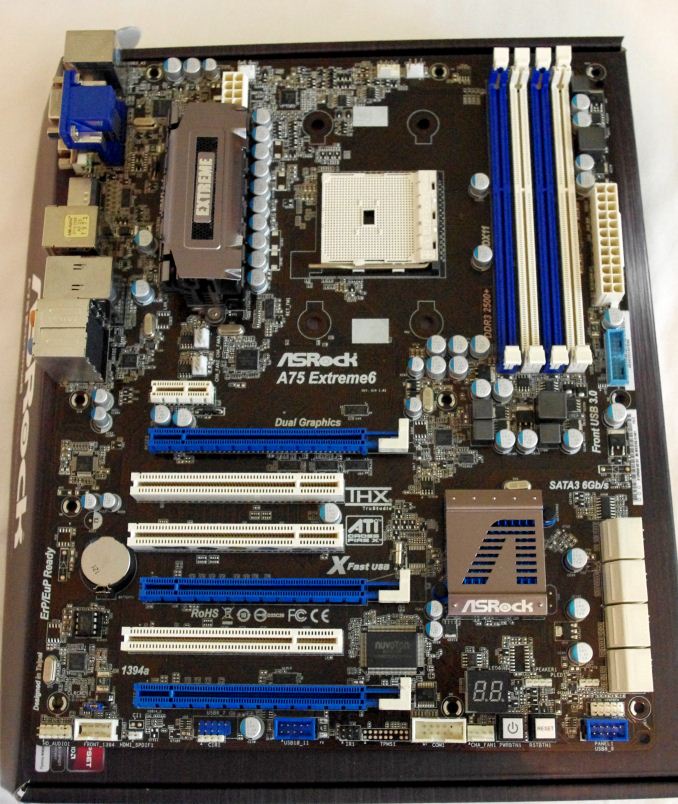
Llano throws a little oddball into the mix, being a true quad core unlike Trinity. The A75-UD4H from Gigabyte was the first one to hand, and offers two PCIe slots at x8/x8. Like the Core2Duo setup, we are not SLI enabled.
After finding an A8-3850 CPU as another point against the A6-3650, I pulled out the A75 Extreme6, which offers three-way CFX as x8/x8 + x4 from the chipset as well as the configurations offered by the A75-UD4H.
For Trinity: The Gigabyte F2A85X-UP4
Technically A85X motherboards for Trinity support up to x8/x8 in Crossfire, but the F2A85X-UP4, like other high end A85X motherboards, implements four lanes from the chipset for 3-way AMD linking. Our initial showing on three-way via that chipset linking was not that great, and this review will help quantify this.
For AM3: The ASUS Crosshair V Formula
As the 990FX covers a lot of processor families, the safest place to sit would be on one of the top motherboards available. Technically the Formula-Z is newer and supports Vishera easier, but we have not had the Formula-Z in to test, and the basic Formula was still able to run an FX-8350 as long as we kept the VRMs cool as a cucumber. The CVF offers up to three-way CFX and SLI testing (x16/x8/x8).
The Memory
Our good friends at G.Skill are putting their best foot forward in supplying us with high end kits to test. The issue with the memory is more dependent on what the motherboard will support – in order to keep testing consistent, no overclocks were performed. This meant that boards and BIOSes limited to a certain DRAM multiplier were set at the maximum multiplier possible. In order to keep things fairer overall, the modules were adjusted for tighter timings. All of this is noted in our final setup lists.
Our main memory testing kit is our trusty G.Skill 4x4 GB DDR3-2400 9-11-11 1.65 V RipjawsX kit which has been part of our motherboard testing for over twelve months. For times when we had two systems being tested side by side, a G.Skill 4x4 GB DDR3-2400 10-12-12 1.65 V TridentX kit was also used.
For The Beast, which is one of the systems that has the issue with higher memory dividers, we pulled in a pair of tri-channel kits from X58 testing. These are high-end kits as well, currently discontinued as they tended to stop working with too much voltage. We have a sets of 3x2 GB OCZ Blade DDR3-2133 8-9-8 and 3x1 GB Dominator GT DDR3-2000 7-8-7 for this purpose, which we ran at 1333 6-7-6 due to motherboard limitations at stock settings.
Our Core2Duo CPUs clearly gets their own DDR2 memory for completeness. This is a 2x2 GB kit of OCZ Platinum DDR2-666 5-5-5.
For Haswell we were offered new kits for testing, this time from Corsair and their Vengeance Pro series. This is a 2x8 GB kit of DDR3-2400 10-12-12 1.65 V.


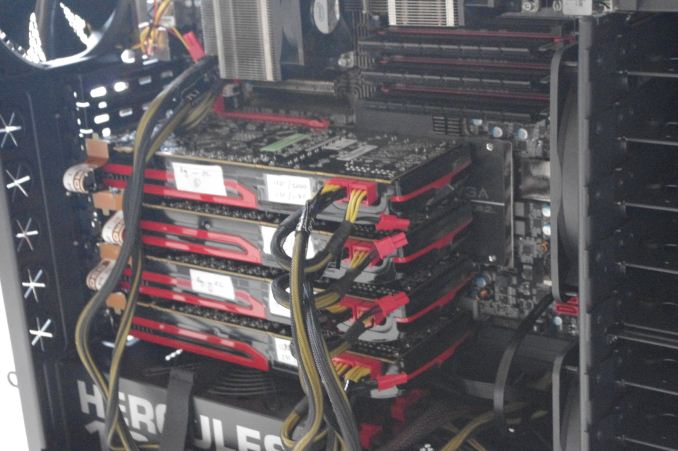
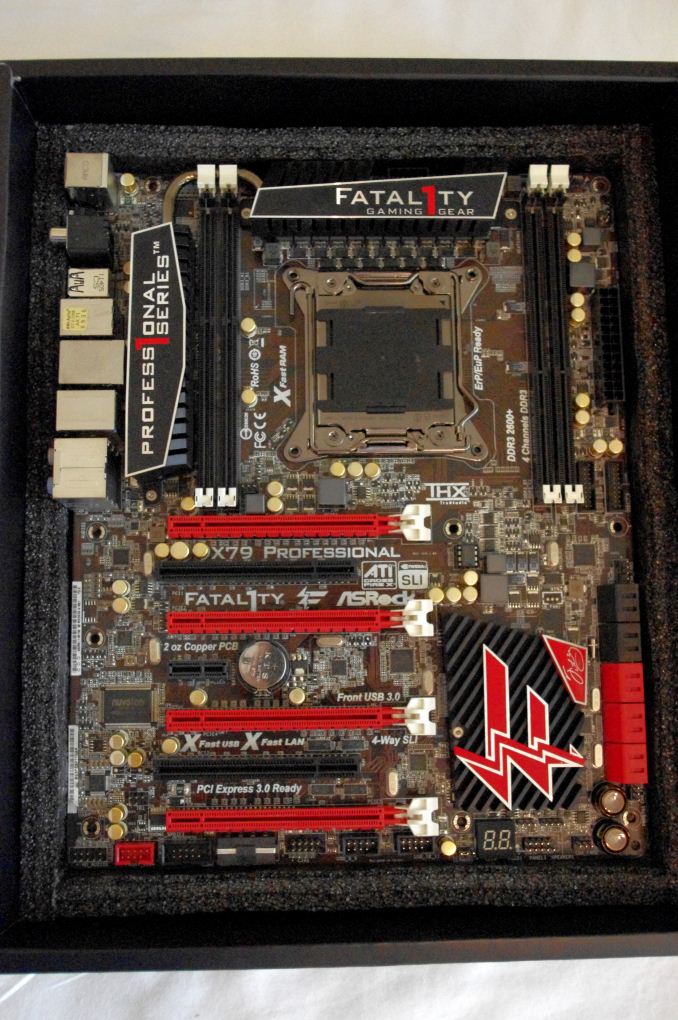
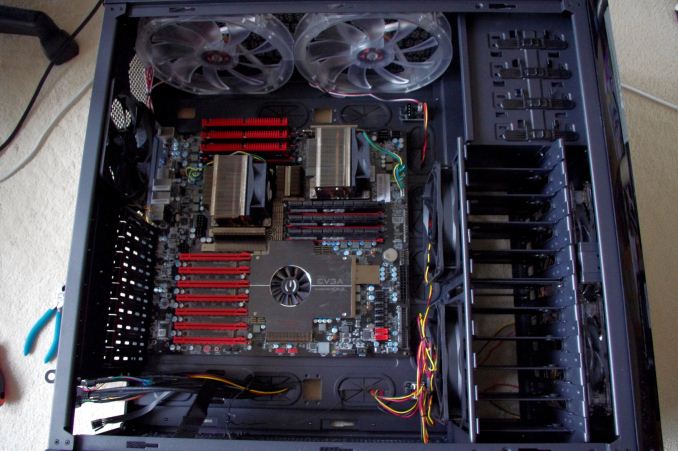
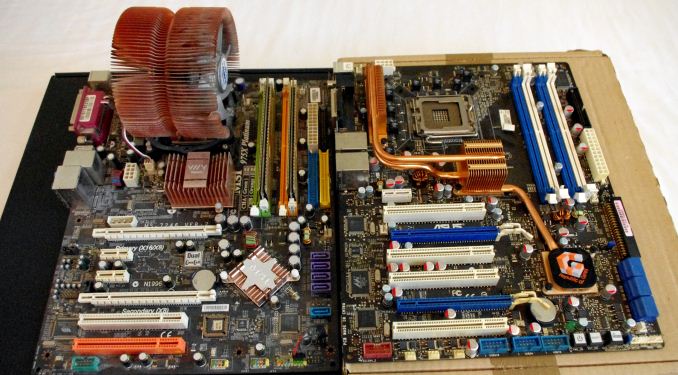
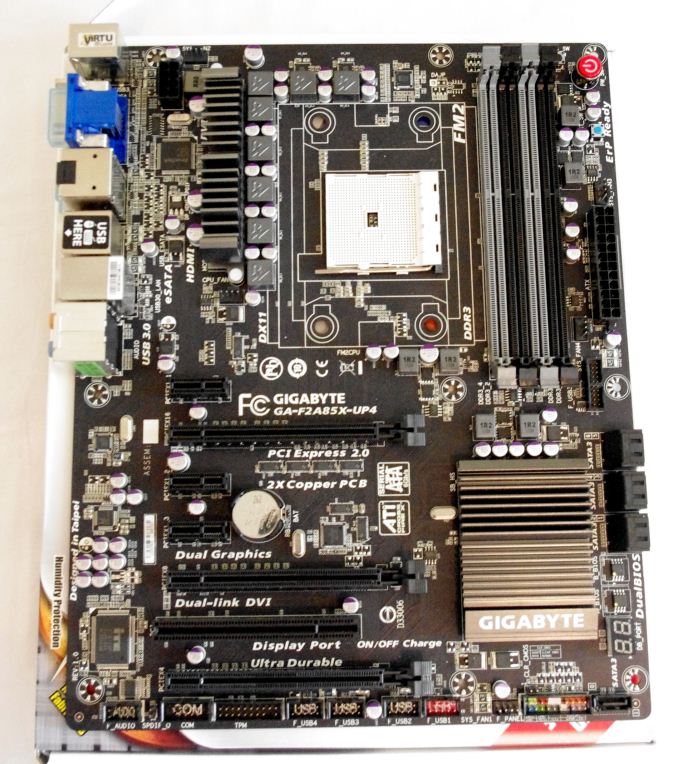
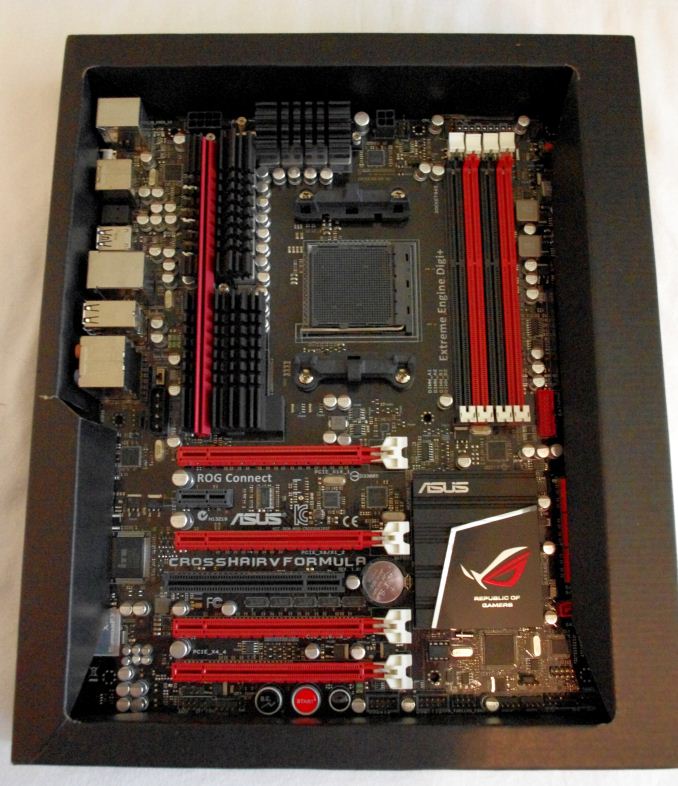

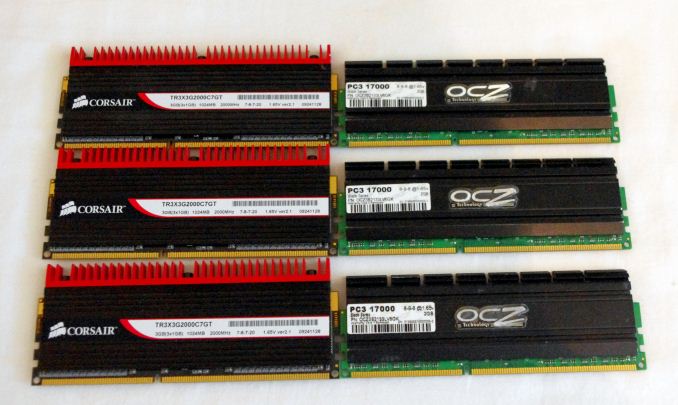
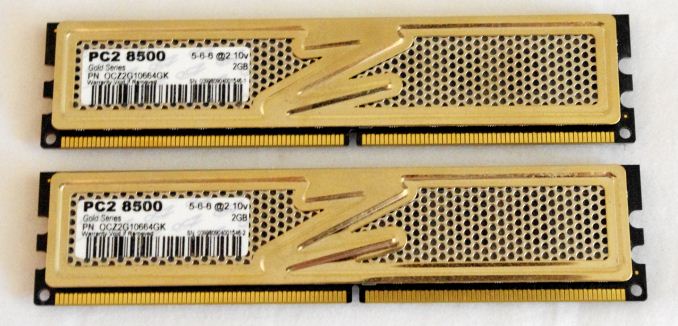
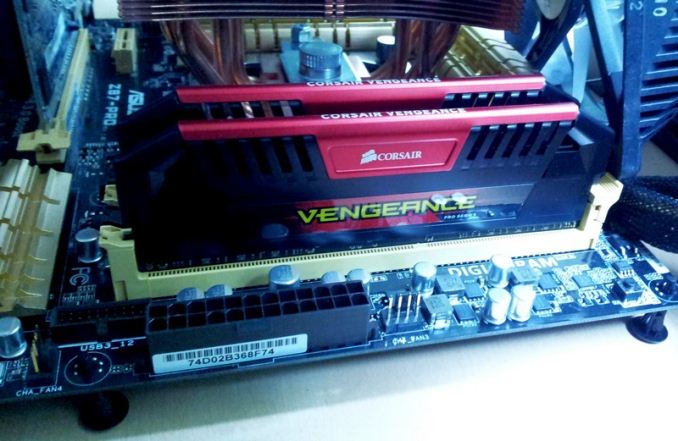








116 Comments
View All Comments
yougotkicked - Tuesday, June 4, 2013 - link
this sounds quite interesting, though I wonder if the AI is runtime bound rather than solution bound, as this could make the testing somewhat nondeterministic.To clarify what I mean; a common method in AI programming is to let algorithms continue searching for better and better solution, interrupting the algorithm when a time limit has passed and taking the best solution it has found so far. Such approaches can result in inconsistent gameplay when pitting multiple AI units against each other, which may change the game state too much between trials to serve as a good testing platform.
Even if the AI does use this approach it may not bias the results enough to matter, so I guess the only way to be sure is to run the tests a few times and see how consistent the results are on a single test system.
Zoeff - Tuesday, June 4, 2013 - link
Forget about SupCom2 - That game has been scaled down quite a bit compared to SupCom1 and isn't as demanding to CPUs. There's also an active SupCom1 community that has and still is pushing out community made patches. :-)SupCom actually has a build-in benchmark that plays a scripted map with some fancy camera work. Anyone can launch this by adding "/map perftest" to your shortcut. That said, it doesn't seem to be working properly anymore after several patches nor does it actually give any useful data as the sim score is capped at 10k for today's CPUs. And yet it's extremely easy to cripple any CPU you throw at it when simply playing the game. Just open up an 81x81km map with 7 AI enemies and watch your computer slow to a crawl as the map starts filling up.
And yes, the AI is "solution bound". Replays of recorded games with AI in them wouldn't work otherwise.
I wonder if somebody could create a custom SupCom1 benchmark... *Hint Hint*
FBB - Tuesday, June 4, 2013 - link
They've had over 5 million concurrent online users. The total number will be much higher.DanNeely - Tuesday, June 4, 2013 - link
What exactly does Steam count as online? Does just having the client sit in my tray count; or do I need to be playing a steam game at the time to be counted?wicko - Tuesday, June 4, 2013 - link
Definitely just signed in: 823,220 Players In-Game | 4,309,324 Players OnlineSource: http://steamcommunity.com/
chizow - Tuesday, June 4, 2013 - link
Thanks for the tests, there's a lot of data points in there so that's always appreciated.I would've liked to have seen some higher perf Nvidia solutions in there though, at the very least some Kepler parts. It looks like a lot of the higher end Intel parts hit a GPU bottleneck at the top, which is not unexpected at 1440p with last-gen Fermi parts.
What it does show for sure is, you may give pause to going beyond 2-way CF/SLI if you have to go lower than x8 on that 3rd slot. Which means you will probably have to shell out for one of the pricier boards. Hard not to recommend X79 at this point for 3-way or higher, although the lack of official PCIe 3.0 support was a red flag for me.
I went with the Gigabyte Z87x UD4 because I don't ever intend to go beyond 2-way SLI and the 3rd slot being x4 (2.0) was better than the x8/x4/x4 (3.0) config on most boards, which gives me the option to run a PhsyX card and retain x8/x8 (3.0) for my two main cards.
Gunbuster - Tuesday, June 4, 2013 - link
So I'll stick with my 2600K @4.5ghz and continue to ponder what new Korean 27" LCD to get. Tech is pretty boring at the moment.wicko - Tuesday, June 4, 2013 - link
I haven't bothered overclocking my 2600K and I still feel it's plenty powerful. I think I may get a second GTX 670 though, Metro Last Light doesn't run all that great at 2560x1440.kallogan - Tuesday, June 4, 2013 - link
Haswell, haswell, haswell. Making one paper per day about it will not make it better. Boring cpu gen. Wake me up when something interesting shows up.chizow - Tuesday, June 4, 2013 - link
So I guess the solution is to just ignore the launch to placate all those who have no interest in the launch, rather than post reviews and info about it for the ones that actually do? Doesn't make a lot of sense.If it doesn't interest you, move along.